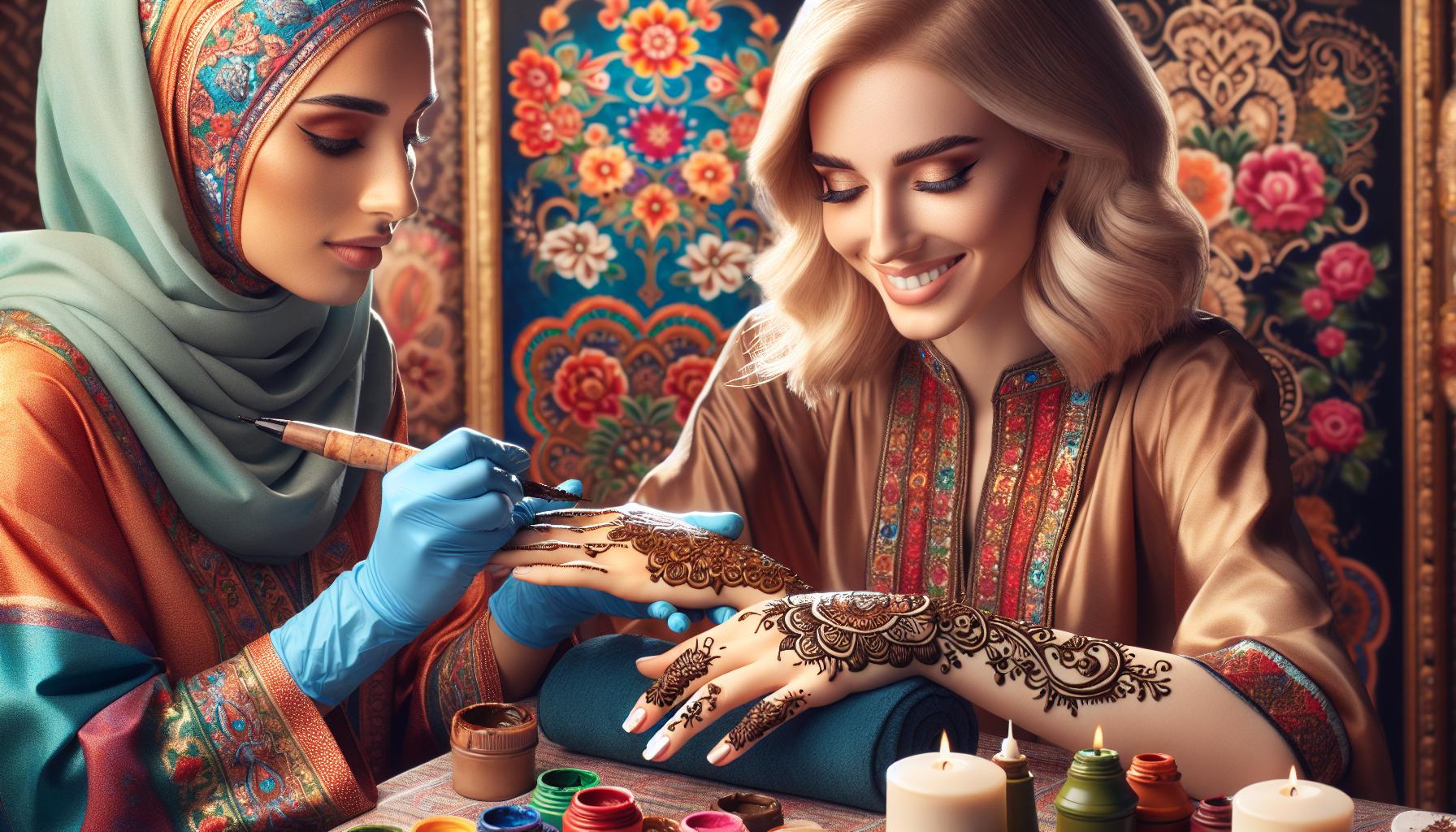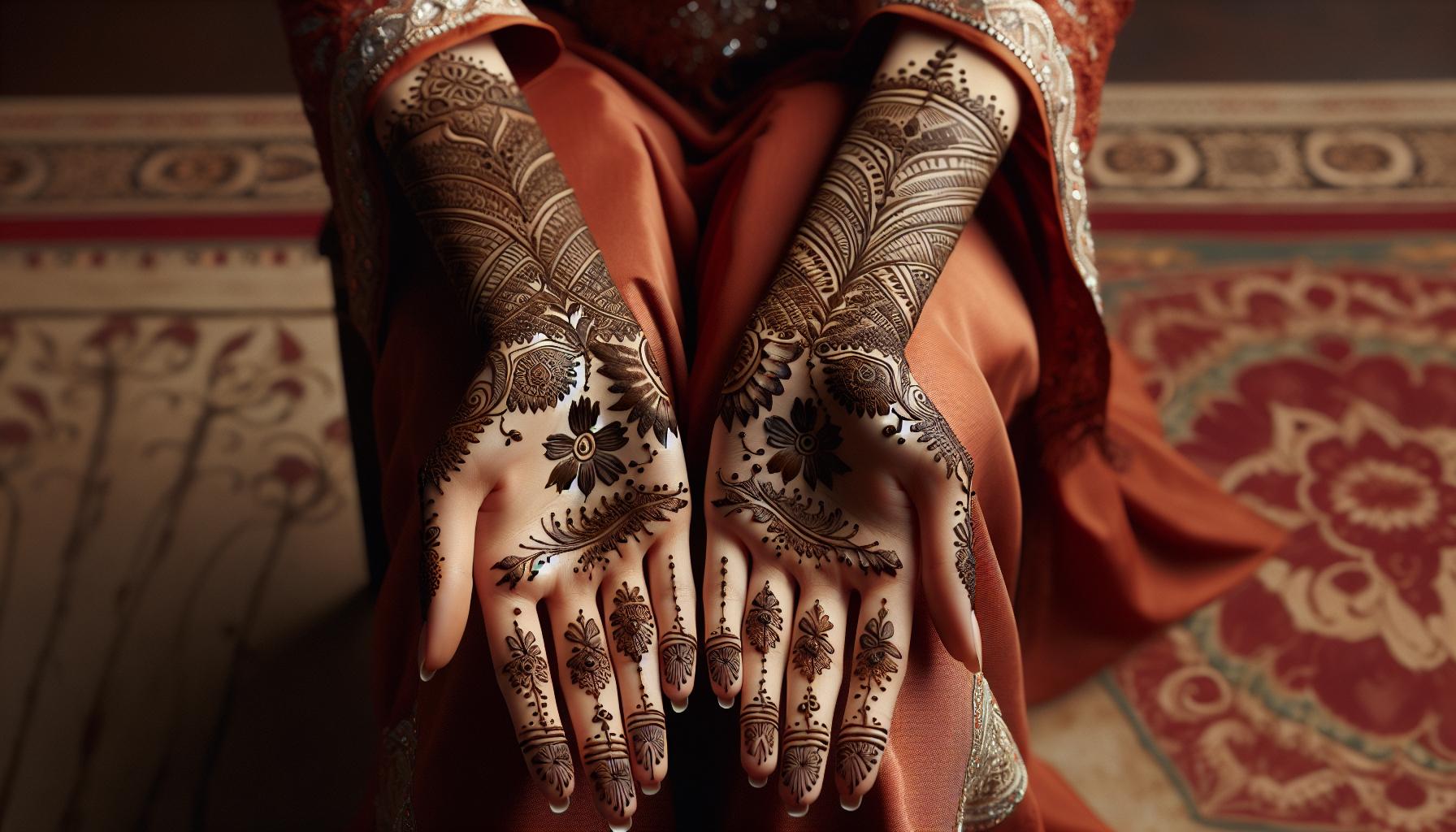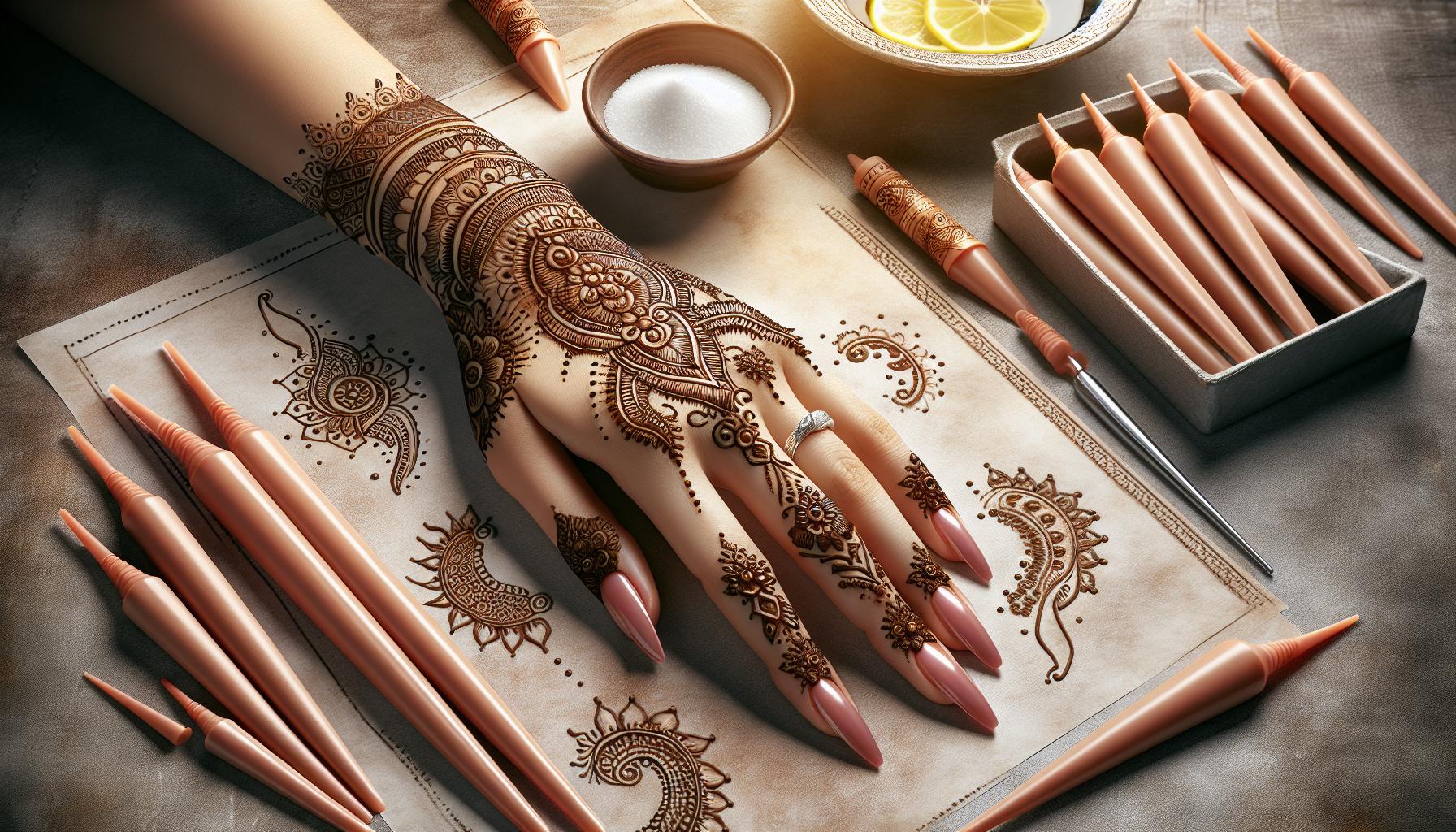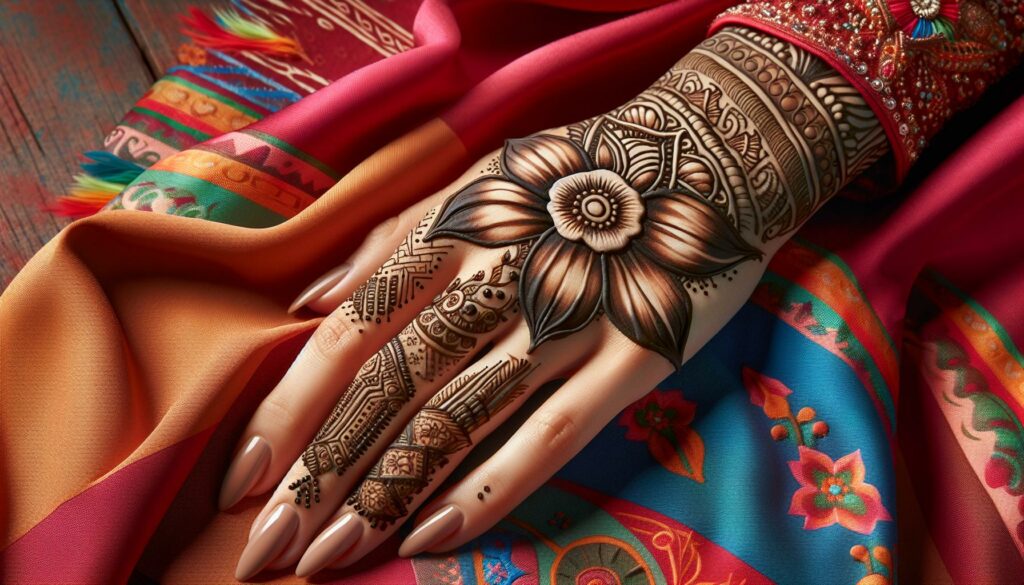I’ve always been fascinated by the intricate art of mehandi design, especially the delicate flower patterns that adorn hands and feet. One stunning variation that’s caught my eye is the flower:dhoi_lkeheo design, a unique blend of traditional and modern elements.
This captivating style combines the grace of floral motifs with the bold lines of contemporary mehandi art. It’s a perfect choice for those looking to make a statement at weddings, festivals, or special occasions. As I’ve explored this design, I’ve discovered its versatility and the way it can be customized to suit individual preferences.
Key Takeaways
- Flower:dhoi_lkeheo= mehandi design combines traditional floral patterns with modern geometric elements, creating a unique and versatile henna art style.
- This design technique incorporates large stylized flower petals, intricate filler patterns, and layered henna application for depth and texture.
- Popular for weddings, festivals, and fashion events, flower:dhoi_lkeheo= mehandi can be customized to suit individual preferences and cultural influences.
- Modern interpretations include minimalist adaptations, 3D textures, color innovations, and digital applications, expanding the style’s versatility.
- Proper care and maintenance, including keeping the design dry and moisturized, can help preserve the flower:dhoi_lkeheo= mehandi’s vibrancy for 2-3 weeks.
Flower:dhoi_lkeheo= Mehandi Design
Flower:dhoi_lkeheo= mehandi design is a unique fusion of traditional floral patterns and contemporary mehandi elements. This innovative style combines the intricate details of classic flower motifs with the bold, geometric shapes characteristic of modern henna art. I’ve observed that the design typically features:
- Large, stylized flower petals
- Intricate filler patterns
- Geometric elements interwoven with floral designs
- Symmetrical layouts with a central focal point
The “dhoi_lkeheo=” component refers to a specific technique used in creating these designs, involving:
- Layering of henna paste
- Precise shading techniques
- Incorporation of negative space
- Use of contrasting textures
This mehandi style is particularly popular for:
- Bridal henna
- Festival celebrations
- Special occasions
- Fashion-forward events
The versatility of flower:dhoi_lkeheo= mehandi allows for customization based on personal preferences and cultural influences. Artists often adapt the design to suit:
- Different hand and arm shapes
- Varying levels of intricacy
- Color preferences (when using colored henna)
- Specific symbolism or meaningful motifs
Table: Key Elements of Flower:dhoi_lkeheo= Mehandi Design
| Element | Description |
|---|---|
| Floral Patterns | Large, stylized flower shapes |
| Geometric Accents | Bold lines and shapes intertwined with floral elements |
| Layering Technique | Multiple layers of henna paste for depth and texture |
| Negative Space | Strategic use of blank areas to enhance overall design |
| Customization | Adaptable to personal style and cultural preferences |
The flower:dhoi_lkeheo= mehandi design stands out for its bold aesthetic and intricate detailing, making it a sought-after choice for those looking to make a statement with their henna art.
History and Origins of This Unique Mehandi Style

The flower:dhoi_lkeheo mehandi design emerged as a fusion of traditional and contemporary henna art techniques. Its roots trace back to ancient Indian and Middle Eastern cultures, where henna application has been practiced for centuries.
The traditional floral patterns in mehandi designs have long been associated with beauty, fertility, and good fortune. These motifs evolved over time, influenced by various regional styles and cultural practices. The incorporation of geometric elements and intricate filler patterns can be attributed to Islamic art, which heavily influenced henna designs in many parts of the world.
The “dhoi_lkeheo” technique, a distinctive feature of this style, originated from innovative artists seeking to add depth and dimension to their work. This layering method was developed by experimenting with different henna paste consistencies and application techniques.
Key milestones in the development of flower:dhoi_lkeheo mehandi include:
- 1980s: Introduction of bolder, more stylized floral patterns
- 1990s: Integration of geometric elements for symmetry and balance
- 2000s: Refinement of the layering technique for enhanced texture
- 2010s: Popularization through social media and global henna communities
The style gained significant popularity in the early 21st century, coinciding with the rise of social media platforms. Henna artists worldwide began sharing their interpretations of the flower:dhoi_lkeheo design, leading to its rapid spread and evolution.
Today, this unique mehandi style represents a harmonious blend of traditional symbolism and modern aesthetics. It continues to evolve, with artists constantly pushing the boundaries of creativity while staying true to its core elements.
Key Elements of Flower:dhoi_lkeheo= Mehandi Designs

Flower:dhoi_lkeheo= mehandi designs are characterized by their unique blend of traditional and modern elements. I’ve identified several key components that make this style stand out in the world of henna art.
Common Floral Motifs
Flower:dhoi_lkeheo= designs prominently feature stylized floral elements. Large, bold petals form the centerpiece of these designs, often radiating outward from a central point. Roses, lotuses, and sunflowers are frequently used motifs, each carrying its own symbolic meaning. Delicate vines and leaves intertwine with the main floral elements, creating a sense of organic flow throughout the design. These floral motifs are typically rendered with varying line weights and shading techniques to add depth and dimension.
Intricate Patterns and Structures
The intricate patterns in flower:dhoi_lkeheo= designs serve as both filler and structural elements. Geometric shapes like circles, triangles, and diamonds are incorporated to create a balanced composition. Mandala-like structures often form the foundation of these designs, providing a symmetrical framework for the floral elements. Fine lines, dots, and swirls are meticulously placed to fill negative space, enhancing the overall texture of the design. The “dhoi_lkeheo” technique is evident in the layering of these patterns, creating a three-dimensional effect that’s visually striking and tactilely appealing.
Application Techniques for Flower:dhoi_lkeheo= Mehandi

Mastering the flower:dhoi_lkeheo= mehandi design requires precision and practice. I’ll guide you through the essential tools, materials, and step-by-step process to create this stunning henna art.
Tools and Materials Needed
To create flower:dhoi_lkeheo= mehandi designs, I use:
- High-quality henna paste
- Applicator cones or bottles with fine tips
- Eucalyptus oil for aftercare
- Cotton swabs and tissues for touch-ups
- A small bowl of lemon juice and sugar solution
- Plastic wrap or medical tape
- Mehandi stencils (optional)
- Glitter or rhinestones for embellishment
These tools ensure smooth application and long-lasting results. I always test the henna paste consistency before starting to achieve the perfect flow for intricate designs.
- Prepare the skin: Cleanse and exfoliate the application area.
- Mix the henna: Achieve a smooth, toothpaste-like consistency.
- Outline the design: Start with the main floral elements.
- Fill in details: Add intricate patterns and geometric accents.
- Layer the design: Apply thicker lines for depth and dimension.
- Create negative space: Strategically leave areas untouched for contrast.
- Add embellishments: Incorporate dots, swirls, and fine lines.
- Allow drying: Let the design air dry for 15-20 minutes.
- Apply fixative: Dab lemon juice and sugar solution over the design.
- Wrap and seal: Cover with plastic wrap for 4-6 hours.
- Remove and moisturize: Gently scrape off dried henna and apply eucalyptus oil.
Following these steps meticulously ensures a vibrant, long-lasting flower:dhoi_lkeheo= mehandi design. Practice each technique to refine your skills and create stunning henna art.
Popular Occasions for Flower:dhoi_lkeheo= Mehandi Designs
I’ve observed that flower:dhoi_lkeheo= mehandi designs are sought-after for numerous special occasions, each highlighting the style’s versatility and aesthetic appeal. Here are some popular events where this intricate design truly shines:
- Weddings:
- Bridal mehandi ceremonies
- Engagement parties
- Pre-wedding photoshoots
- Cultural Festivals:
- Diwali
- Eid
- Karva Chauth
- Life Milestones:
- Baby showers
- Coming-of-age ceremonies
- Graduation celebrations
- Seasonal Events:
- Spring equinox festivals
- Summer solstice gatherings
- Harvest festivals
- Fashion and Entertainment:
- Runway shows
- Music video productions
- Red carpet events
- Religious Ceremonies:
- Temple visits
- Religious pilgrimages
- Sacred rituals
The flower:dhoi_lkeheo= design’s adaptability allows for customization to suit each occasion’s specific requirements. For weddings, I’ve seen elaborate, full-hand designs that incorporate personalized elements like the couple’s initials or wedding date. During festivals, the patterns often feature motifs relevant to the celebration, such as diyas for Diwali or crescent moons for Eid.
Fashion-forward events typically showcase bold, contemporary interpretations of the flower:dhoi_lkeheo= style, pushing the boundaries of traditional mehandi art. These designs often incorporate unconventional color combinations or avant-garde patterns that complement haute couture outfits.
Religious ceremonies call for more subdued versions of the flower:dhoi_lkeheo= design, focusing on sacred symbols and auspicious patterns. These designs are typically applied to smaller areas of the hands or feet, respecting the solemnity of the occasion while still embracing the beauty of the art form.
For seasonal events, I’ve noticed that artists often draw inspiration from nature, incorporating seasonal flowers or weather-related elements into the flower:dhoi_lkeheo= designs. This creates a harmonious connection between the art and the environment, enhancing the overall aesthetic experience.
The versatility of flower:dhoi_lkeheo= mehandi designs makes them a popular choice for various occasions, allowing individuals to express their personal style while honoring cultural traditions and celebrating life’s special moments.
Modern Interpretations and Variations
I’ve observed several exciting modern interpretations and variations of the flower:dhoi_lkeheo mehandi design that push the boundaries of traditional henna art. These innovative approaches blend contemporary aesthetics with time-honored techniques, resulting in stunning and unique creations.
Minimalist Adaptations
Minimalist flower:dhoi_lkeheo designs feature:
- Simplified floral outlines
- Sparse detailing
- Strategic use of negative space
- Limited color palette, often using white henna
These sleek interpretations maintain the essence of the flower:dhoi_lkeheo style while appealing to modern sensibilities.
Fusion with Other Art Forms
Artists are incorporating elements from various art styles into flower:dhoi_lkeheo designs:
- Watercolor effects: Soft, blended edges and gradient shading
- Mandala-inspired patterns: Intricate circular designs within floral motifs
- Geometric abstractions: Angular interpretations of traditional floral elements
- Dotwork techniques: Pointillism-style shading and texturing
This fusion approach creates visually striking and unique mehandi designs.
3D and Textured Designs
Three-dimensional flower:dhoi_lkeheo designs add depth and tactile interest:
| Technique | Description |
|---|---|
| Layering | Multiple applications of henna to create raised patterns |
| Embossing | Using thicker henna paste for select elements |
| Glitter accents | Adding sparkle to enhance specific design features |
| Jewelry-inspired | Incorporating intricate, jewelry-like details |
These techniques transform flat designs into dynamic, multi-dimensional artworks.
Color Innovations
While traditional mehandi uses natural henna, modern interpretations explore diverse color options:
- Vibrant, multi-colored designs using safe, skin-friendly dyes
- Metallic henna in gold, silver, and copper tones
- Glow-in-the-dark henna for unique nighttime effects
- Ombre and gradient color transitions within the design
These color variations add a contemporary flair to classic flower:dhoi_lkeheo patterns.
Digital and Temporary Adaptations
Technology and temporary applications have expanded the reach of flower:dhoi_lkeheo designs:
- Digital mehandi art for virtual try-ons and customization
- Temporary tattoo versions for quick application
- Stencil-based designs for DIY enthusiasts
- Henna-inspired nail art and body paint
These adaptations make the style more accessible and versatile for various occasions.
Maintaining and Caring for Your Flower:dhoi_lkeheo= Mehandi Design
I’ve found that proper maintenance and care are crucial for preserving the beauty and longevity of your flower:dhoi_lkeheo= mehandi design. Here are essential tips to keep your henna art looking vibrant:
- Avoid water contact:
- Keep the design dry for 24-48 hours after application
- Use plastic wrap or gloves when washing hands or bathing
- Pat dry gently if accidental water exposure occurs
- Apply a fixative solution:
- Mix lemon juice and sugar for a natural sealant
- Dab the solution onto the dried henna design
- Reapply 2-3 times during the first day
- Moisturize regularly:
- Use natural oils like eucalyptus or lavender
- Apply a thin layer to the design twice daily
- Avoid petroleum-based products that can fade the color
- Protect from excessive heat:
- Limit exposure to hot water, saunas, or steam rooms
- Use sunscreen to prevent fading from UV rays
- Avoid chlorinated pools and saltwater for extended periods
- Exfoliate gently:
- Wait at least a week before exfoliating
- Use a soft cloth or mild scrub to remove flaking henna
- Moisturize immediately after exfoliation
- Touch up fading areas:
- Use henna-based temporary tattoo pens for quick fixes
- Focus on the intricate details of the flower:dhoi_lkeheo= design
- Reapply a thin layer of henna paste for more extensive touch-ups
By following these maintenance steps, your flower:dhoi_lkeheo= mehandi design can retain its vibrancy for 2-3 weeks. Remember, individual results may vary based on skin type, lifestyle, and initial application quality.
Perfect Blend of Tradition
The flower:dhoi_lkeheo mehandi design truly embodies the perfect blend of tradition and innovation. Its intricate patterns, bold floral motifs, and layered techniques make it a standout choice for any occasion. I’ve explored its rich history, application methods, and modern interpretations, showcasing its versatility and enduring appeal.
With proper care and maintenance, these stunning designs can last for weeks, serving as a beautiful reminder of life’s special moments. As mehandi art continues to evolve, the flower:dhoi_lkeheo style remains at the forefront, inspiring artists and enthusiasts alike to push creative boundaries while honoring cultural heritage.

